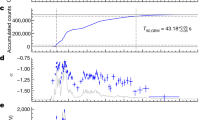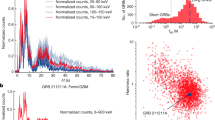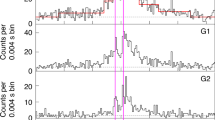Abstract
Mergers of neutron stars are known to be associated with short γ-ray bursts1,2,3,4. If the neutron-star equation of state is sufficiently stiff (that is, the pressure increases sharply as the density increases), at least some such mergers will leave behind a supramassive or even a stable neutron star that spins rapidly with a strong magnetic field5,6,7,8 (that is, a magnetar). Such a magnetar signature may have been observed in the form of the X-ray plateau that follows up to half of observed short γ-ray bursts9,10. However, it has been expected that some X-ray transients powered by binary neutron-star mergers may not be associated with a short γ-ray burst11,12. A fast X-ray transient (CDF-S XT1) was recently found to be associated with a faint host galaxy, the redshift of which is unknown13. Its X-ray and host-galaxy properties allow several possible explanations including a short γ-ray burst seen off-axis, a low-luminosity γ-ray burst at high redshift, or a tidal disruption event involving an intermediate-mass black hole and a white dwarf13. Here we report a second X-ray transient, CDF-S XT2, that is associated with a galaxy at redshift z = 0.738 (ref. 14). The measured light curve is fully consistent with the X-ray transient being powered by a millisecond magnetar. More intriguingly, CDF-S XT2 lies in the outskirts of its star-forming host galaxy with a moderate offset from the galaxy centre, as short γ-ray bursts often do15,16. The estimated event-rate density of similar X-ray transients, when corrected to the local value, is consistent with the event-rate density of binary neutron-star mergers that is robustly inferred from the detection of the gravitational-wave event GW170817.
This is a preview of subscription content, access via your institution
Access options
Access Nature and 54 other Nature Portfolio journals
Get Nature+, our best-value online-access subscription
$29.99 / 30 days
cancel any time
Subscribe to this journal
Receive 51 print issues and online access
$199.00 per year
only $3.90 per issue
Buy this article
- Purchase on Springer Link
- Instant access to full article PDF
Prices may be subject to local taxes which are calculated during checkout



Similar content being viewed by others
Data availability
The data that support the plots within this paper and other findings of this study are available from the corresponding authors upon reasonable request.
References
Abbott, B. P. et al. GW170817: observation of gravitational waves from a binary neutron star inspiral. Phys. Rev. Lett. 119, 161101 (2017).
Abbott, B. P. et al. Gravitational waves and gamma-rays from a binary neutron star merger: GW170817 and GRB 170817A. Astrophys. J. Lett. 848, L13 (2017).
Goldstein, A. et al. An ordinary short gamma-ray burst with extraordinary implications: Fermi-GBM detection of GRB 170817A. Astrophys. J. Lett. 848, L14 (2017).
Zhang, B.-B. et al. A peculiar low-luminosity short gamma-ray burst from a double neutron star merger progenitor. Nat. Commun. 9, 447–452 (2018).
Dai, Z. G., Wang, X. Y., Wu, X. F. & Zhang, B. X-ray flares from postmerger millisecond pulsars. Science 311, 1127–1129 (2006).
Gao, W.-H. & Fan, Y.-Z. Short-living supermassive magnetar model for the early X-ray flares following short GRBs. Chin. J. Astron. Astrophys. 6, 513–516 (2006).
Metzger, B. D., Quataert, E. & Thompson, T. A. Short-duration gamma-ray bursts with extended emission from protomagnetar spin-down. Mon. Not. R. Astron. Soc. 385, 1455–1460 (2008).
Bucciantini, N., Metzger, B. D., Thompson, T. A. & Quataert, E. Short gamma-ray bursts with extended emission from magnetar birth: jet formation and collimation. Mon. Not. R. Astron. Soc. 419, 1537–1545 (2012).
Rowlinson, A., O’Brien, P. T., Metzger, B. D., Tanvir, N. R. & Levan, A. J. Signatures of magnetar central engines in short GRB light curves. Mon. Not. R. Astron. Soc. 430, 1061–1087 (2013).
Lü, H.-J., Zhang, B., Lei, W.-H., Li, Y. & Lasky, P. D. The millisecond magnetar central engine in short GRBs. Astrophys. J. 805, 89 (2015).
Zhang, B. Early X-ray and optical afterglow of gravitational wave bursts from mergers of binary neutron stars. Astrophys. J. Lett. 763, L22 (2013).
Sun, H., Zhang, B. & Gao, H. X-ray counterpart of gravitational waves due to binary neutron star mergers: light curves, luminosity function, and event rate density. Astrophys. J. 835, 7 (2017).
Bauer, F. E. et al. A new, faint population of X-ray transients. Mon. Not. R. Astron. Soc. 467, 4841–4857 (2017).
Zheng, X. C. et al. Deepest view of AGN X-ray variability with the 7 Ms Chandra Deep Field-South Survey. Astrophys. J. 849, 127 (2017).
Fong, W., Berger, E. & Fox, D. B. Hubble Space Telescope observations of short gamma-ray burst host galaxies: morphologies, offsets, and local environments. Astrophys. J. 708, 9–25 (2010).
Berger, E. Short-duration gamma-ray bursts. Ann. Rev. Astron. Astrophys. 52, 43–105 (2014).
Luo, B. et al. The Chandra Deep Field-South Survey: 7 Ms source catalogs. Astrophys. J . Suppl. 228, 2 (2017).
Xue, Y. Q. The Chandra deep fields: lifting the veil on distant active galactic nuclei and X-ray emitting galaxies. New Astron. Rev. 79, 59–84 (2017).
Foreman-Mackey, D., Hogg, D. W., Lang, D. & Goodman, J. emcee: The MCMC hammer. Pub. Astron. Soc. Pacif. 125, 306–312 (2013).
Park, T. et al. Bayesian estimation of hardness ratios: modeling and computations. Astrophys. J. 652, 610–628 (2006).
The Planck Collaboration. Planck 2015 results. XIII. Cosmological parameters. Astron. Astrophys. 594, A13 (2016).
Guo, Y. et al. CANDELS multi-wavelength catalogs: source detection and photometry in the GOODS-South field. Astrophys. J. Suppl. 207, 24 (2013).
Santini, P. et al. Stellar masses from the CANDELS survey: the GOODS-South and UDS fields. Astrophys. J. 801, 97 (2015).
Bruzual, G. & Charlot, S. Stellar population synthesis at the resolution of 2003. Mon. Not. R. Astron. Soc. 344, 1000–1028 (2003).
Speagle, J. S., Steinhardt, C. L., Capak, P. L. & Silverman, J. D. A highly consistent framework for the evolution of the star-forming “main sequence” from z~0–6. Astrophys. J. Suppl. 214, 15 (2014).
Blanchard, P. K., Berger, E. & Fong, W.-f. The offset and host light distributions of long gamma-ray bursts: a new view from HST observations of Swift bursts. Astrophys. J. 817, 144 (2016).
Li, Y., Zhang, B. & Lü, H.-J. A comparative study of long and short GRBs. I. Overlapping properties. Astrophys. J. Suppl. 227, 7 (2016).
Dai, Z. G. & Lu, T. Gamma-ray burst afterglows and evolution of postburst fireballs with energy injection from strongly magnetic millisecond pulsars. Astron. Astrophys. 333, L87–L90 (1998).
Zhang, B. & Mészáros, P. Gamma-ray burst afterglow with continuous energy injection: signature of a highly magnetized millisecond pulsar. Astrophys. J. 552, L35–L38 (2001).
Sun, H., Zhang, B. & Li, Z. Extragalactic high-energy transients: event rate densities and luminosity functions. Astrophys. J. 812, 33 (2015).
Broos, P. S. et al. Innovations in the analysis of Chandra-ACIS observations. Astrophys. J. 714, 1582–1605 (2010).
Hsieh, B.-C. et al. The Taiwan ECDFS Near-Infrared Survey: ultra-deep J and KS imaging in the extended Chandra Deep Field-South. Astrophys. J. Suppl. 203, 23 (2012).
Kraft, R. P., Burrows, D. N. & Nousek, J. A. Determination of confidence limits for experiments with low numbers of counts. Astrophys. J. 374, 344–355 (1991).
Burns, E. et al. Do the Fermi Gamma-Ray Burst Monitor and Swift Burst Alert Telescope see the same short gamma-ray bursts? Astrophys. J. 818, 110 (2016).
Arnaud, K. A. XSPEC: the first ten years. In Astronomical Data Analysis Software and Systems V (eds Jacoby, G. H. & Barnes, J.) Vol. 101, 17–20 (Astronomical Society of the Pacific Conference Series, 1996).
Stark, A. A. et al. The Bell Laboratories H I survey. Astrophys. J. Suppl. 79, 77–104 (1992).
Akaike, H. A new look at the statistical model identification. IEEE Trans. Automat. Contr. 19, 716–723 (1974).
Xue, Y. Q. et al. The Chandra Deep Field-South Survey: 4 Ms source catalogs. Astrophys. J. Suppl. 195, 10 (2011).
Silverman, J. D. et al. The Extended Chandra Deep Field-South Survey: optical spectroscopy of faint X-ray sources with the VLT and Keck. Astrophys. J. Suppl. 191, 124–142 (2010).
Margalit, B. & Metzger, B. D. Constraining the maximum mass of neutron stars from multi-messenger observations of GW170817. Astrophys. J. Lett. 850, L19 (2017).
Pooley, D., Kumar, P., Wheeler, J. C. & Grossan, B. GW170817 most likely made a black hole. Astrophys. J. Lett. 859, L23 (2018).
Ruiz, M., Shapiro, S. L. & Tsokaros, A. GW170817, general relativistic magnetohydrodynamic simulations, and the neutron star maximum mass. Phys. Rev. D 97, 021501 (2018).
Rezzolla, L., Most, E. R. & Weih, L. R. Using gravitational-wave observations and quasi-universal relations to constrain the maximum mass of neutron stars. Astrophys. J. Lett. 852, L25 (2018).
Ai, S. et al. The allowed parameter space of a long-lived neutron star as the merger remnant of GW170817. Preprint at https://arxiv.org/abs/1802.00571 (2018).
Yu, Y.-W., Liu, L.-D. & Dai, Z.-G. A long-lived remnant neutron star after GW170817 inferred from its associated kilonova. Preprint at https://arxiv.org/abs/1711.01898 (2017).
Li, S.-Z., Liu, L.-D., Yu, Y.-W. & Zhang, B. What powered the optical transient AT2017gfo associated with GW170817? Preprint at https://arxiv.org/abs/1804.06597 (2018).
Piro, L. et al. A long-lived neutron star merger remnant in GW170817: constraints and clues from X-ray observations. Mon. Not. R. Astron. Soc. 483, 1912–1921 (2019).
Lasky, P. D., Haskell, B., Ravi, V., Howell, E. J. & Coward, D. M. Nuclear equation of state from observations of short gamma-ray burst remnants. Phys. Rev. D 89, 047302 (2014).
Gao, H., Zhang, B. & Lü, H.-J. Constraints on binary neutron star merger product from short GRB observations. Phys. Rev. D 93, 044065 (2016).
Li, A. et al. Internal X-ray plateau in short GRBs: signature of supramassive fast-rotating quark stars? Phys. Rev. D 94, 083010 (2016).
Komossa, S. Tidal disruption of stars by supermassive black holes: status of observations. J. High Energy Astrophys. 7, 148–157 (2015).
Burrows, D. N. et al. Relativistic jet activity from the tidal disruption of a star by a massive black hole. Nature 476, 421–424 (2011).
Granot, J., Panaitescu, A., Kumar, P. & Woosley, S. E. Off-axis afterglow emission from jetted gamma-ray bursts. Astrophys. J. 570, L61–L64 (2002).
Campana, S. et al. The association of GRB 060218 with a supernova and the evolution of the shock wave. Nature 442, 1008–1010 (2006).
Wiersema, K. et al. The nature of the dwarf starforming galaxy associated with GRB 060218/SN 2006aj. Astron. Astrophys. 464, 529–539 (2007).
Soderberg, A. M. et al. An extremely luminous X-ray outburst at the birth of a supernova. Nature 453, 469–474 (2008).
Huertas-Company, M. et al. A catalog of visual-like morphologies in the 5 CANDELS fields using deep learning. Astrophys. J. Suppl. 221, 8 (2015).
Acknowledgements
We thank A. Lien, K. Hurley and D. Svinkin for examining the relevant Swift/BAT, IPN3, and Wind/KNOUS data, respectively, for us. Y.Q.X., X.C.Z., J.Y.L. and M.Y.S. acknowledge support from the 973 Program (2015CB857004), the National Natural Science Foundation of China (grant numbers NSFC-11473026, NSFC-11890693 and NSFC-11421303), the CAS Frontier Science Key Research Program (QYZDJ-SSW-SLH006), the China Scholarship Council (CSC)-Leiden University Joint Scholarship Program, the China Postdoctoral Science Foundation (2016M600485), and the K. C. Wong Education Foundation. Y.L. acknowledges support by the KIAA-CAS Fellowship, which is jointly supported by Peking University and the Chinese Academy of Sciences. W.N.B. and G.Y. acknowledge support from Chandra X-ray Center grant AR8-19016X, NASA grant NNX17AF07G, NASA ADP grant 80NSSC18K0878 and the V. M. Willaman Endowment. B.L. acknowledges support from the National Key R&D Program of China (2016YFA0400702) and NSFC-11673010. B.-B.Z. acknowledges support from the National Thousand Young Talents programme of China and the National Key Research and Development Program of China (2018YFA0404204) and NSFC-11833003. F.E.B. acknowledges support from CONICyT-Chile (Basal AFB-170002, FONDECyT Regular 1141218, FONDO ALMA 31160033) and the Ministry of Economy, Development, and Tourism’s Millennium Science Initiative through grant IC120009, awarded to The Millennium Institute of Astrophysics (MAS). F.V. acknowledges financial support from CONICyT and CASSACA through the fourth call for tenders of the CAS-CONICyT fund.
Author information
Authors and Affiliations
Contributions
Y.Q.X. and X.C.Z. discovered CDF-S XT2, and led the Chandra data reduction and analysis, estimation of rise time and event rate density, and compilation and analysis of multiwavelength properties, with inputs from W.N.B., B.L., F.E.B., B.D.L., G.Y., X.K., J.Y.L., M.Y.S., J.-X.W. and F.V. B.Z. and X.-F.W. proposed the theoretical model to explain the data. Y.Q.X., X.C.Z. and B.Z. wrote the manuscript. Y.L. analysed the HST data, measured the offset with inputs from X.C.Z. and Y.Q.X., computed the Flight parameter and the probability O(II:I)host, and compared X-ray and γ-ray properties with those of SGRBs. B.-B.Z. analysed the Fermi data and computed relevant flux and luminosity upper limits; B.-B.Z. and X.C.Z. examined the INTEGRAL and Swift data. H.S. calculated the local event rate density with inputs from X.C.Z. and Y.Q.X. All authors contributed to the manuscript.
Corresponding authors
Ethics declarations
Competing interests
The authors declare no competing interests.
Additional information
Publisher’s note: Springer Nature remains neutral with regard to jurisdictional claims in published maps and institutional affiliations.
Extended data figures and tables
Extended Data Fig. 1 Multiwavelength images of the CDF-S XT2 neighbourhood.
a, Merged Chandra 0.5–7-keV image including the entire 7-Ms CDF-S survey. b, Same as a, but excluding ObsID 16453. c, Chandra 0.5–7-keV image from ObsID 16453 alone. The large dashed circle marks the source region (r = 3.5″) for the extraction of light curves and spectra. The X-ray images in a–c are rendered in counts using the same linear scale, with pixel values ranging from 0 to 8. d, HST/CANDELS F160W image. In each panel, the small red circle marks the position and 1σ positional uncertainty of the source with XID7Ms 330 reported in the 7-Ms CDF-S main catalogue17, while the cyan circle denotes that of the source with XID4Ms 256 reported in the 4-Ms CDF-S main catalogue38. The magenta numbers and crosses mark the object numbers of the six closest galaxies to CDF-S XT2 (see Extended Data Table 2) and their positions in the CANDELS F160W DR1 catalogue22, respectively. For clarity, the position of CDF-S XT2 is not annotated; it is slightly (about 0.3″) northeastern to that of XID7Ms 330.
Rights and permissions
About this article
Cite this article
Xue, Y.Q., Zheng, X.C., Li, Y. et al. A magnetar-powered X-ray transient as the aftermath of a binary neutron-star merger. Nature 568, 198–201 (2019). https://doi.org/10.1038/s41586-019-1079-5
Received:
Accepted:
Published:
Issue Date:
DOI: https://doi.org/10.1038/s41586-019-1079-5
This article is cited by
-
Correction to: X-Ray Properties of TDEs
Space Science Reviews (2021)
-
The evolution of binary neutron star post-merger remnants: a review
General Relativity and Gravitation (2021)
-
Time domain astronomy with the THESEUS satellite
Experimental Astronomy (2021)
-
X-Ray Properties of TDEs
Space Science Reviews (2020)
-
Neutron star mergers and how to study them
Living Reviews in Relativity (2020)
Comments
By submitting a comment you agree to abide by our Terms and Community Guidelines. If you find something abusive or that does not comply with our terms or guidelines please flag it as inappropriate.



